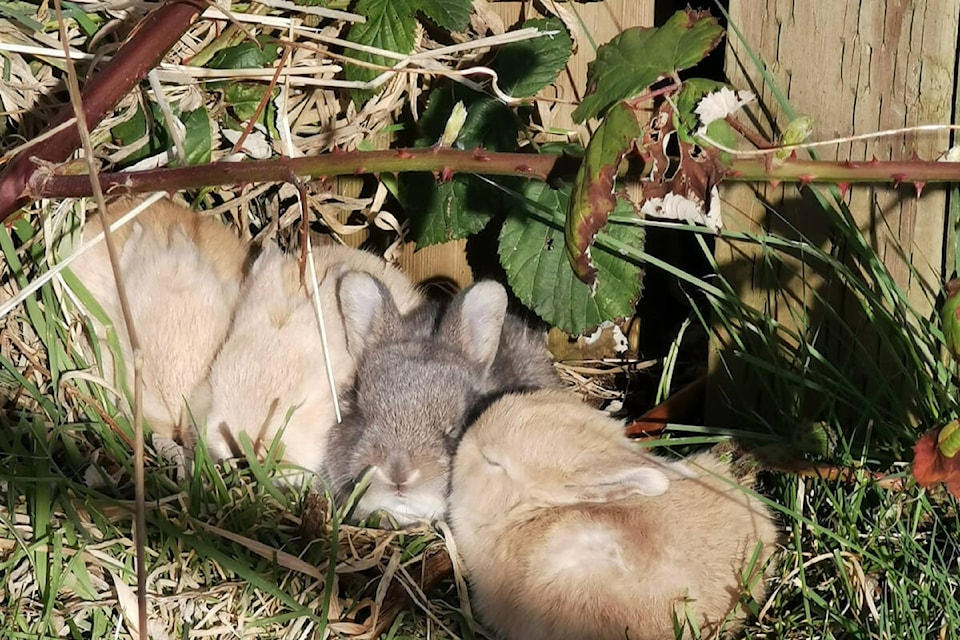People want desperately to help a bundle of baby bunnies discovered basking in the sun on an Esquimalt construction site – but there’s nowhere for them to go.
A mother rabbit and handful of kits were discovered mid-March and neighbours rapidly took to social media in search of help.
Many reached out to Amy’s Bunny Barn, a Sooke-based non-profit that takes in abandoned domestic rabbits. But they’re full – a persistent problem, according to Amy McLaughlin.
McLaughlin runs the non-profit that currently houses about 50 rabbits. The shelter is always full, she said, with numbers consistently just shy of 70 bunnies – many at her home with the rest scattered across the Island in different foster homes.
READ ALSO: Herds of feral rabbits at threat in Greater Victoria
Across the province, BC SPCA sites are also overrun with rabbits. Aside from a limited capacity for housing them, free-living bunnies must go through a specific quarantine due to the lethal and highly infectious rabbit hemorrhagic disease, said Sara Dubois, senior director, standards, science and policy with the BC SPCA.
After an absence, the disease reappeared on the Island in February – confirmed by the BC SPCA in dead feral rabbits in Courtenay. It’s the first time since 2019 the virus has been found in B.C. but it was also identified in feral and wild rabbits in Alberta in September 2022.
Bunnies also fall through the cracks because they’re designated feral under the wildlife act, though regulatory changes last year allow people to trap them. The province pegged the changes expressly as a way to manage feral rabbits and reduce their spread.
“People can rescue them without a permit so that was a good step,” Dubois said.
READ ALSO: B.C. cracks down on invasive rabbit populations
Most assume the Esquimalt bunnies were dumped near the construction site and with no one to take them in, could literally multiply like rabbits. Dumped rabbits not taken into care can quickly become colonies because they can start having babies as young as four to six months, birthing a litter of kittens every 30 days, McLaughlin said.
She said there are a couple of notable dumping grounds in Greater Victoria – such as Elk Lake and a specific part of Metchosin – but it’s a problem across the Island.
In the past, ditched rabbits developed strong colonies on both at the University of Victoria and the greenway near Helmcken overpass on Highway 1.
“We don’t want to go back to where we were with the Helmcken or UVic situation,” Dubois said.
READ ALSO: Colwood seeks solution as rabbits run rampant in Royal Bay
By 2016, the Helmcken rabbit population was so significant it created traffic hazards and undermined infrastructure. About 100 were captured and relocated and rescuers found they were in rough shape – most of the females were pregnant and the males had beaten each other up. Unfortunately, dumping continued, prompting to province to put up signs and cameras.
“We have provisions for stray dogs and stray cats and ‘Why are rabbits being left behind?’ is really the question,” Dubois said.
READ ALSO: Bunny owners beware, feral rabbits die of ‘highly infectious’ virus in Saanich
While a longstanding problem, it’s not unsolvable, she said, adding it requires community effort with key contributions from the pet industry and government.
“They’re just really neglected animals,” McLaughlin said. “People get bunnies from breeders, or online for free, and then they don’t want to fork out $400 to $500 to get them fixed.”
Taking in a mom and babies now could actually rack up to 12 rabbits quickly, with a high chance the older female is pregnant again.
“The likelihood someone is going to spay or neuter a rabbit is lower than cats and dogs,” Dubois said.
READ ALSO: Animal advocates applaud plan to eliminate all rabbits from UVic campus
Those looking at bunnies as a potential pet have a part to play as well.
Both Dubois and McLaughlin point out rabbits live for 10 years and they’re animals with specific needs that are not always easy.
In the meantime, one kitten (baby bunny) was picked up from the Esquimalt site, but the rest remain – living, eating and doing that other thing rabbits do.
christine.vanreeuwk@blackpress.ca
@van_reeuwyk
christine.vanreeuwyk@blackpress.ca
Like us on Facebook and follow us on Twitter.
